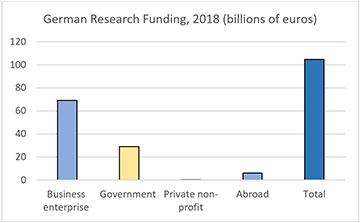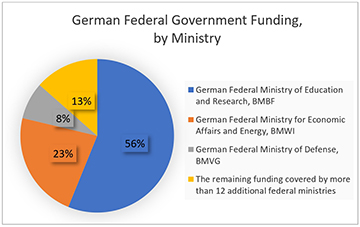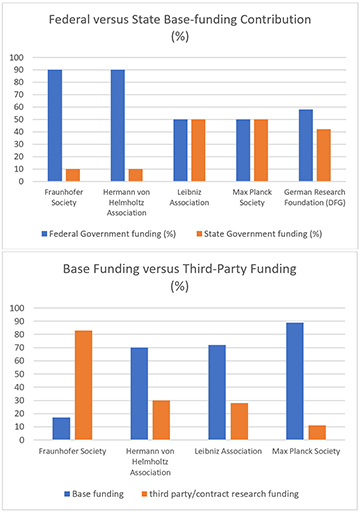[Source: German Federal Ministry of Education and Research BMBF] [Enlarge image]
Claus Roll is a director of research and program development for OSA Europe.
News stories about European research funding often dwell on EU-level spending—particularly on Horizon Europe, the seven-year, €95.5 billion (US$115.8 billion) framework program covering the period from 2021 through 2027. Yet, impressive as that seven-year EU funding number sounds, it’s dwarfed by the research spending commitment of some individual countries within the union. In Germany, for example, a combination of government, industry and other sources spent some €104.8 billion on research across all disciplines in 2018—a single year.
Understanding European research funding at the country level and where it’s headed, therefore, is arguably far more important than following the twists and turns of the EU program. As a step toward a clearer view, we here begin a series of OPN stories that take a deeper dive into how country-level government research funding works in the union’s largest economy, Germany—and the place of optics and photonics within that scheme. In this first installment, we look broadly at the share of funding provided by the German federal and state governments, and how it’s managed.
Substantial research investment
According to the German Federal Ministry of Education and Research, Germany’s total 2018 research spending of €104.8 billion constituted around 3.13% of the country’s GDP. That percentage, OECD data (accessible via the BMBF data portal) suggest, puts the country’s research investment as a share of GDP well above the mean EU effort (2.0% of GDP) and somewhat ahead of that of the United States (2.8% of GDP), but behind that of societies such as South Korea (4.5%) and Japan (3.3%).
Of the total 2020 research funding in Germany from all sources, federal and state government research funding amounted to a bit less than a third. The federal share funnels through a variety of different ministries, each with different emphases ranging from basic and applied sciences to engineering.
[Source: German Federal Ministry of Education and Research BMBF] [Enlarge image]
In simplest terms, the German Federal Ministry of Education and Research (BMBF) supports basic research, the German Federal Ministry for Economic Affairs (BMWI) funds applied research, and the German Federal Ministry of Defense (BMVG) supports any research issues related to defense. Together, those three behemoth ministries account for some 87% of total federal research funding in Germany. The remaining 13% is covered by 12 much smaller federal ministries.
Setting federal and state funding levels—and growth
In addition to federal support, public research funding in Germany is distinguished by active support from a number of German states—and by significant coordination between the state and federal governments in planning their long-term research spending.
Specifically, in 2005, the German federal and state governments initiated a mechanism—called the Pakt für Forschung und Innovation (PFI)—under which they together establish a fixed annual financial envelope and target specific, steady yearly increases. This mechanism allows the governments to take into account the yearly cost evolution for key German research institutes, such as the Fraunhofer Institute and the Max Planck Society, as well as for the independent German Research Foundation.
The scheme sets predictable conditions and arguably strengthens the institutes’ ability to develop long-term research projects. The current funding period, which began this year, runs until 2030 and will apply a 3% increase to the overall federal and state research budget each year.
At the research institutes
[Source: Joint Science Conference (Gemeinsame Wissenschaftskonferenz – GWK)] [Enlarge image]
While PFI sets the overall level and growth rate for government funding at Germany’s research institutes, the proportion of federal versus state funding at different institutes, or for different projects, varies significantly. The Fraunhofer Institute, for example, gets 90% of its base funding from federal sources and 10% from state sources, whereas the split is closer to 50-50 for the Leibniz Association and Max Planck.
Moreover, beyond this base funding and depending on the research organizations’ scope, they also actively work to acquire contract-based third-party project funding—a share of which likewise comes from government sources. At the Fraunhofer Society, for example, research contracts with industry represent 47% of third-party funding and public sources the remaining 53%. The proportion of industry versus public third-party funding in the other three institutions is much lower.
At universities, apart from funding for educational activities, government funds research through different mechanisms, such as the German Excellence Strategy and large-scale facility and infrastructure projects. Here again, federal ministries and state ministries contribute at different levels depending on the type of project.
Optics and photonics: Uncertain scope
So where do optics and photonics fit into this broad German public-funding picture? Unfortunately, it’s impossible to get a single reliable figure of the scope, because different German funding agencies, ministries and research organizations track optics and photonics research in different ways. Of course, the BMBF’s “optical technologies” column holds projects or research related to optics and photonics—but optics also plays a role in a variety of other domains such as electronic systems, microsystems, nanotechnologies and material technologies.
With that very large caveat, the BMBF lists 2020 German federal government funding of research labelled as “optical technologies” at a total of €245.8 million—approximately 1.2% of a total federal research funding budget of €20.3 billion for the year. That, as already noted, is very much a lower limit, as it does not account for funding of other fields that involve or integrate optics and photonics.
Correction, 25 March 2021, 12:15 GMT: In the original version of this article, the split of Frauhofer Institute third-party funding between industry contracts and public sources was misstated. The numbers have been corrected in the text above.
In the next installment of this series, Claus Roll will drill down into optics and photonics funding by the German Research Foundation, an independent funding organization whose budget comes from the federal and state governments.



